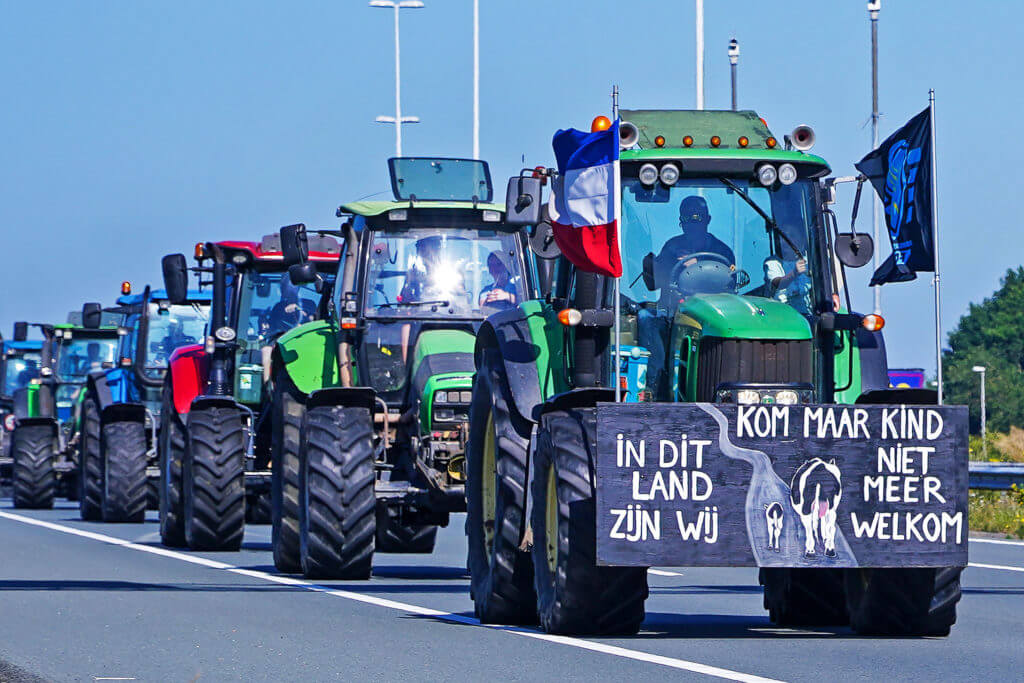Since June, tens of thousands of angry farmers have been protesting across the Netherlands against the government’s decision to impose stringent emission reductions for fertilisers, with demonstrators using tractors to block roads, bringing cows to the parliament, dumping hay bales on roads, and starting bonfires outside government buildings. Farmers across European countries like Germany, Italy, Spain, and Poland also marched in solidarity with their Dutch counterparts. Canadian farmers, too, have expressed support for the Dutch protests and formed a stiff opposition against their own government’s legislation to curb fertiliser usage as well.
Days before the protests, the Dutch government made a series of proposals to combat climate change by curbing energy-intensive agricultural practices, including a 30% reduction in livestock holdings per farmer and 90-95% cuts in fertiliser emissions to curb nitrogen pollution by 2050. Similarly, the Canadian government demanded that farmers reduce emissions from fertilisers by 30% by 2030. The EU has also proposed stringent curbs on synthetic fertilisers.
According to the Dutch and Canadian proposals, emissions reductions would help in cutting nitrogen pollution levels by 70% within a decade. Nitrogen-based fertilisers account for over 50% of total energy use in agriculture and its production process guzzles large amounts of natural gas and coal. Fertilisers also contribute to a large proportion of agricultural greenhouse gas emissions. In addition, the proposals are in line with the 2015 Paris Climate Agreement, which aims to limit global warming levels to less than two degrees Celsius above pre-industrial levels.
While fighting climate change has emerged as a top priority for countries, farmers have warned that measures to cut fertiliser emissions would mean that they would have to switch to alternative sources like using organic fertilisers. They note that since they do not yet have access to and adequate knowledge about alternatives, the emissions reduction mandates would end up hurting the farming community.
Sri Lanka is a case in point. In 2021, Colombo banned farmers from using synthetic fertilisers and the government decreed a 100% shift to organic farming. The move turned out to be a disaster for the country’s farming community and plunged it into a much larger economic crisis. It left over two million farmers, around 27% of Sri Lanka’s labour force, without access to fertilisers. As result, it was extremely difficult to cultivate fertiliser-intensive crops like rice and tea. For example, rice production fell by 20% within the first 20 days of the ban. Tea production fell by 18% and the export of Sri Lanka’s main cash crop was at its lowest level in a quarter of a century. One of the main reasons for the ban was to save hundreds of millions of dollars on fertiliser imports. However, the government had to chalk out more money in subsidies to compensate farmers for production losses and spend around $450 million importing rice. The resulting shortage caused widespread hunger, leading to increased demand and as a result, rising food prices. Experts note that the food crisis caused by the fertiliser ban was one of the major causes of Sri Lanka’s political turmoil.
Against this backdrop, agricultural groups have argued that emissions reduction from fertilisers should not come at the expense of farmers’ livelihoods. A study by fertiliser Canada notes that cutting fertiliser use to reduce emissions could result in Canadian farmers losing $48 billion in profits over the next eight years. The report also projects a loss of around 160 million metric tonnes of canola, corn, and wheat, three of Canada’s main grain exports, from 2023 to 2030.
The situation would be made worse by the global fertiliser shortage caused by the Russia-Ukraine war. Fertiliser prices have skyrocketed due to the conflict as a result of sanctions imposed on Russia, which is the largest exporter of fertilisers. Both Canada and the EU have banned imports of Russian fertilisers. A study conducted by Reuters across 34 countries found that bans on Russian fertiliser imports have had a global effect and resulted in rising costs of fertilisers, increased instances of stockpiling fertilisers, widespread shortages, and rising food inflation. Therefore, farmers, who are already struggling with high fertiliser and input costs, have warned that absolute emission reduction targets would not only badly impact their livelihoods but cause food prices to skyrocket and create food shortages.
The World Bank has described rising fertiliser prices as a “serious threat” to global food security and thus called on countries to ensure that fertilisers are “more accessible and affordable.” Noting that fertilisers are important to ramp up food production, the World Bank says rather than ban fertiliser production and imports, countries should focus on ways to ensure that fertilisers are used efficiently, urging governments to supplement synthetic fertiliser use with organic ones and calling for a more gradual transition to alternative sources.
In this regard, Fertiliser Canada notes that governments can make fertiliser usage more efficient by implementing a “4R” strategy—right source, right rate, right time, and right place. It urges governments to ensure that farmers are using the correct fertilisers, applying the right rate of chemicals, and adding them at the right time.
Therefore, it is important that countries weigh the consequences of both climate change and fertiliser emissions reductions. Combating climate change cannot be done at the risk of creating shocks in the agricultural sector, and any reduction in fertiliser usage should be gradual. If not, farmers stand to lose billions in revenue and crop production would be severely hampered.
Curbing Fertiliser Use Is a Disaster Waiting to Happen
The economic disaster caused by Sri Lanka’s fertiliser ban serves as a stark warning for other countries not to take absolute measures to restrict fertiliser usage.
August 12, 2022

Farmers protest in tractors in the Netherlands IMAGE SOURCE: AP
